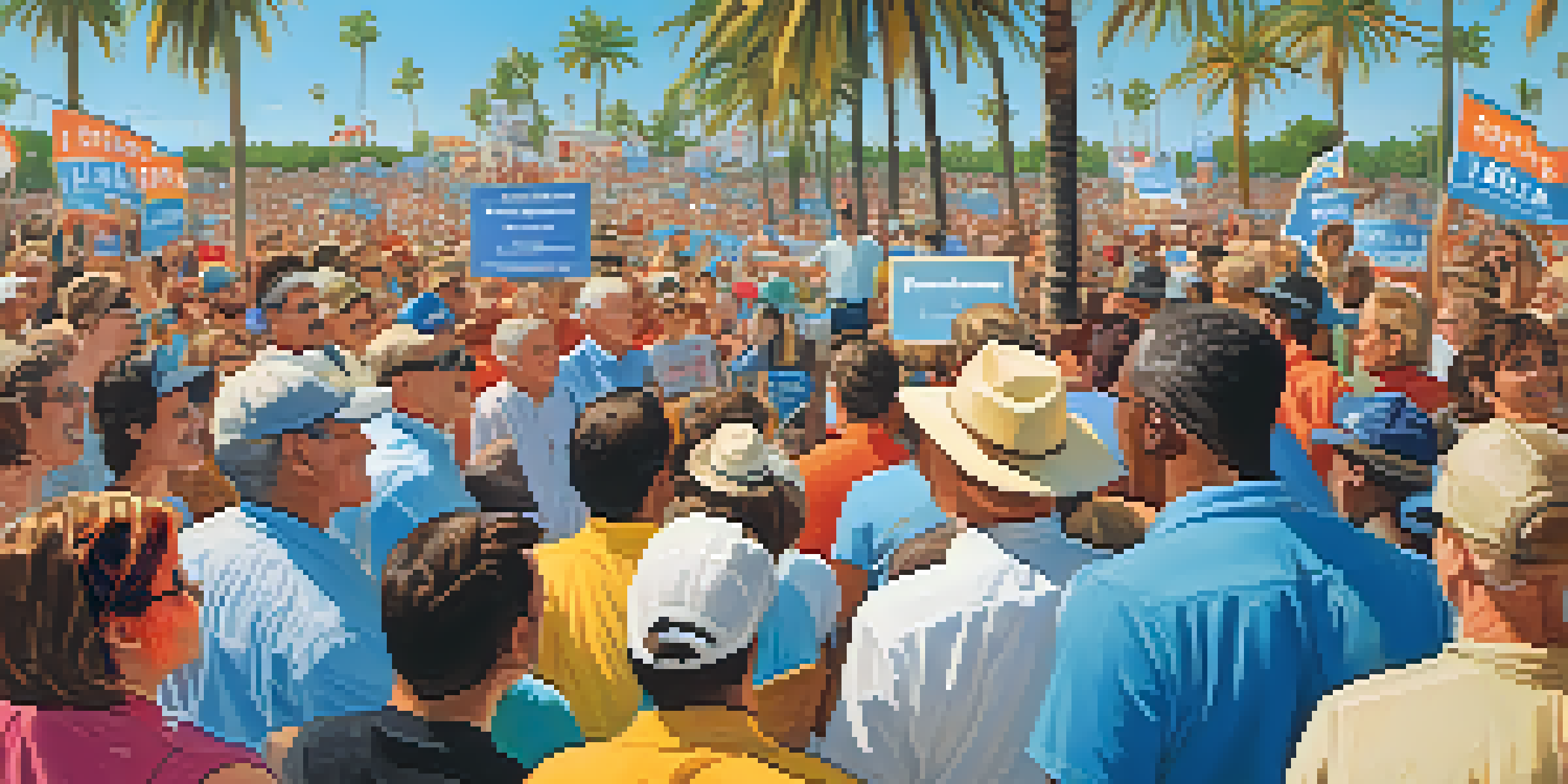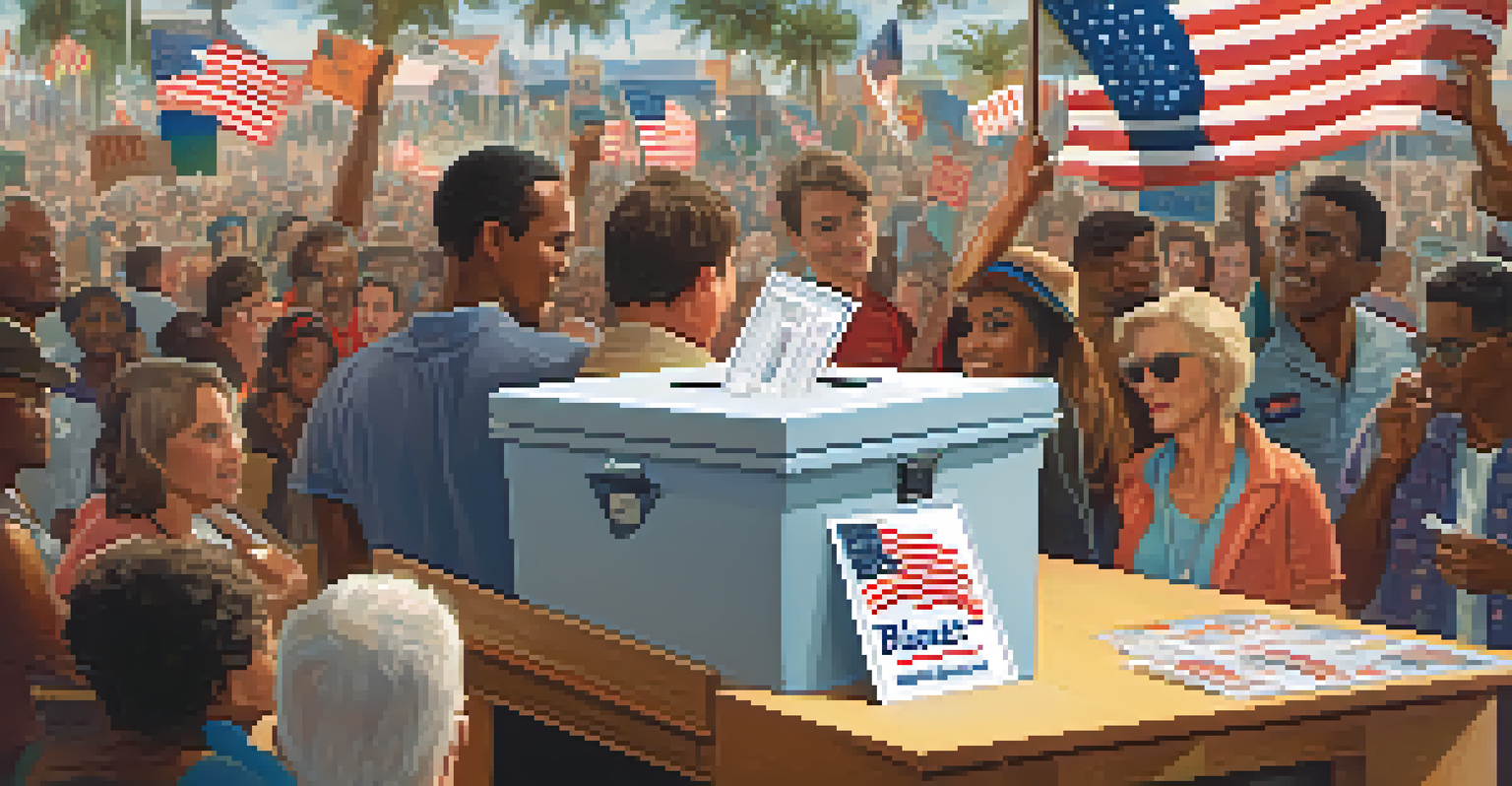The Role of Political Parties in Florida's Governance and Elections

Understanding Florida's Political Landscape
Florida's political landscape is as diverse as its population, featuring a mix of urban and rural areas, retirees and young professionals. This diversity creates a unique environment for political parties to operate, influencing everything from policy decisions to election outcomes. The state has a long history of being a battleground, where both major parties—Republicans and Democrats—vie for control.
In politics, if you want anything said, ask a man; if you want something done, ask a woman.
In recent years, the rise of independent voters has further complicated this landscape. These voters often do not align strictly with either party, which can sway election results significantly. Political parties in Florida must adapt to this evolving electorate, making their platforms more appealing to a broader audience.
Moreover, Florida's importance in presidential elections cannot be overstated. With its 29 electoral votes, the state is a critical prize that both parties seek to secure. Understanding the dynamics of political parties here is essential for grasping how national politics unfold.
The Two-Party System in Florida
Florida is predominantly a two-party state, with the Republican and Democratic parties holding the most influence. The Republican Party has enjoyed significant success in recent years, winning major statewide offices and legislative control. This dominance can be attributed to a combination of strong party organization, effective fundraising, and alignment with the values of many Florida voters.

On the other hand, the Democratic Party faces challenges in mobilizing support across diverse demographics. While they have made inroads in urban areas, rural regions tend to lean Republican. This divide highlights the need for Democrats to craft policies that resonate with a wider array of voters, including those in less populated areas.
Diverse Voter Landscape in Florida
Florida's political scene is shaped by a mix of urban and rural voters, alongside a growing number of independent voters.
Despite the challenges, both parties play vital roles in shaping Florida's policies and governance. The competition between them drives voter engagement and ensures that various perspectives are represented in the political discourse.
Role of Political Parties in Elections
Political parties are instrumental in organizing and running elections in Florida. They help candidates navigate the complex electoral process, from filing paperwork to campaigning effectively. This support is crucial for ensuring that candidates can focus on their message and connect with voters.
The best argument against democracy is a five-minute conversation with the average voter.
Moreover, parties play a key role in mobilizing voters. They organize rallies, phone banks, and door-to-door canvassing efforts to encourage voter turnout. During elections, a strong party infrastructure can make a significant difference, especially in close races where every vote counts.
Additionally, political parties in Florida work to shape the narrative around elections. Through advertising, social media, and public events, they communicate their vision and policies, influencing public perception and voter decisions. This multifaceted approach helps solidify their presence in the electoral process.
Impact of Third Parties in Florida
While the Republican and Democratic parties dominate Florida's political scene, third parties also play a role in shaping elections. Parties like the Libertarian Party and the Green Party may not win many offices, but they can influence the political conversation and draw votes away from the major parties. This impact can be especially pronounced in close races.
Third parties often bring attention to specific issues that may be overlooked by the major parties. For example, the Green Party emphasizes environmental concerns, while the Libertarians advocate for personal freedoms and limited government. By pushing these topics into the mainstream, they can compel larger parties to address them.
Impact of Two-Party System
The Republican and Democratic parties dominate Florida's politics, but must constantly adapt to engage a diverse electorate.
In some cases, third-party candidates can act as spoilers, altering the outcome of elections. This phenomenon highlights the importance of understanding the broader political ecosystem in Florida, where every vote and every candidate can shift the balance of power.
How Political Parties Shape Policy Decisions
Political parties are not just about elections; they also play a crucial role in shaping public policy in Florida. Once in office, elected officials often rely on their party's platform to guide their decisions on key issues such as healthcare, education, and the environment. This alignment ensures that the party's values are reflected in governance.
Moreover, party leadership influences legislative priorities and the allocation of resources. For instance, when Republicans hold the majority, policies may lean toward tax cuts and deregulation, while Democrats may prioritize social programs and environmental protections. The party in power thus has a significant impact on the direction of the state's policies.
Additionally, political parties engage in lobbying efforts to advocate for specific legislation. They work with interest groups and constituents to push for laws that align with their platform, further solidifying their role in shaping the state's governance.
Voter Engagement and Political Parties
Voter engagement is a cornerstone of democracy, and political parties in Florida actively work to boost participation. They conduct outreach efforts to educate voters about the electoral process, important issues, and the candidates on the ballot. By making information accessible, they empower citizens to make informed choices.
Furthermore, parties organize events and initiatives aimed at increasing voter turnout, especially among underrepresented groups. This includes efforts to engage young voters, minorities, and low-income residents. By fostering inclusivity, parties enhance the democratic process and ensure that diverse voices are heard.
Role of Third Parties
Third parties, while not dominant, influence elections by raising specific issues and potentially swaying major party votes.
Ultimately, the engagement strategies employed by political parties can significantly influence election outcomes. A highly engaged electorate is more likely to participate in elections, leading to a more representative government.
The Future of Political Parties in Florida
As Florida continues to evolve, so too will its political parties. With changing demographics and shifting voter priorities, both major parties must adapt to stay relevant. This might mean re-evaluating their platforms, outreach strategies, and engagement efforts to align with the needs of Florida's diverse population.
Additionally, the rise of independent voters poses a challenge for both parties. To capture this crucial segment of the electorate, parties may need to broaden their appeals and address a wider range of issues. This could lead to a more moderate and inclusive political landscape in the state.

Looking ahead, the role of political parties in Florida's governance and elections will remain pivotal. Their ability to adapt and connect with voters will determine not just their success in elections, but also the future direction of policies that impact all Floridians.